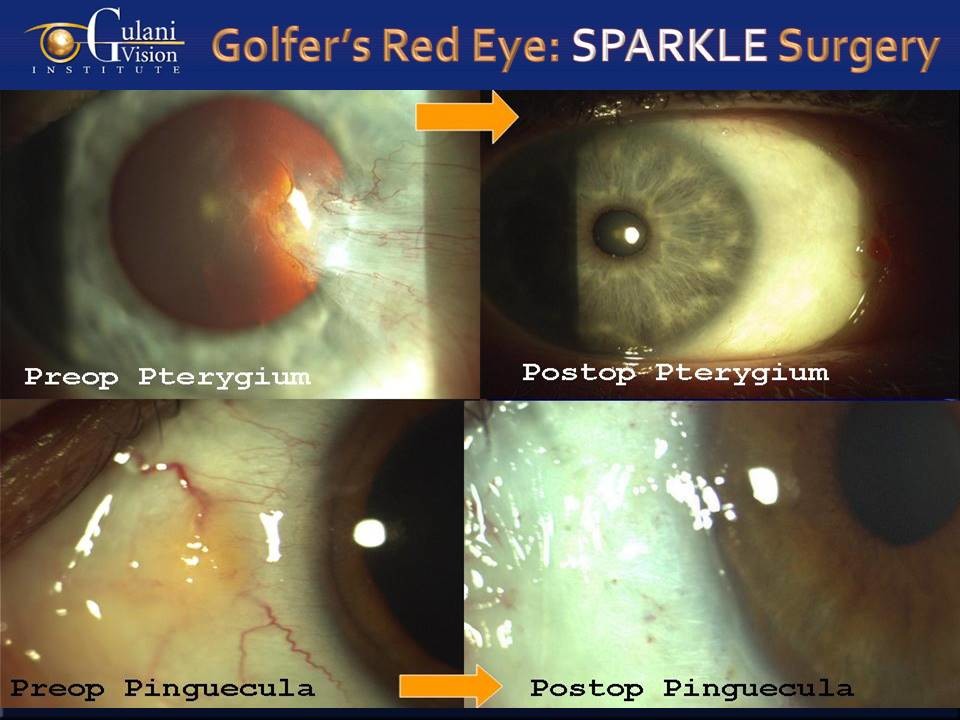Golfer’s eyes
While strokes and stance are what’s typically on a golfer’s mind, the tranquil yet intense environment that characterizes the sport does call for more than usual TLC for their eyes.
The vision demands and environmental exposure related to golf-associated eye concerns can be classified into the following categories for ease of understanding and future surgical correction:
- Quantity of vision, such as 20/40, 20/20, etc.
- Quality of vision, such as contrast sensitivity to decipher different levels of visual inputs in different lighting conditions; depth perception to best apply learned techniques in three dimensions; and spatial resolution to plan and direct putting and long drives effectively.
- Red appearance of the eyes from pterygium and dry eyes.
When these faculties are in synch and normalcy with hand-eye coordination, we can expect perfect execution for what the mind has planned in this mentally intuitive sport. However, this is not always the case. Below is a brief look at some of the procedures that can be done for golfers’ eyes to improve their game.
Beyond 20/20 vision
Recently introduced Bladeless, Flapless and No Cut NextGen Lasik techniques can help most golfers even see 20/20 and in many cases even beyond 20/20.
Golfers who wear contact lenses or glasses may have nearsightedness (myopia), farsightedness (hyperopia) or astigmatism (football shaped cornea). With today’s technology, we can diagnose and measure to the minutest level of vision involvement and then correct these using computer drive, micron-precision laser technology.
Presbyopia in golfers as they advance in age (beyond 40 years) requires reading glasses because the natural lens inside the eye stops zooming (no more “tele” and “wide” zooming like a camera does). As a result, they need to keep their score cards at a further distance with their arms outstretched to read or record. This condition, called Presbyopia, can be addressed with new generation lens and laser techniques.
For those golfers in their 60s, vision gets cloudy and dim due to cataracts (a cataract is a cloudy transformation of our crystal clear, natural lens). This cataract can be removed using modern, No-Stitch, laser techniques and replaced by an artificial lens implant that can allow them to see without glasses at distance and near. Such lens implants can be Monofocal; Toric (astigmatism correcting); multifocal like ReStor or Symphony; Trifocal; or accommodative like Crystalens and Trulign lens implants.
Additionally, cataract surgery can even be staged with Nexgen Lasik, and patients who had Lasik surgery in their past can now avail of these new generation cataract surgery technologies to once again completely fix the optics of their eyes for a glasses-free vision experience.
Even patients who have undergone previous cataract surgery and did not have a choice of these advanced, multifocal/progressive lens implants at that time can now benefit from New Generation Lasik surgery to help them get rid of glasses altogether.
Dry eyes
Continuous exposure to allergens, tear evaporation and repeated challenges to their ocular surface from the sun induces dry eyes in golfers that can be corrected with today’s technological advances.
Lacrimal plugs (for water layer of the tear film) and Meibomian Gland Probing (MGP for the lipid layer of the tear film), along with LipiFlow, Lipiview and newly introduced medication eye drops, can now help numerous patients with dry eyes.
Red “Golfer’s” Eyes
Pterygium is a red, unsightly lesion on the white of the eyes that is rampant among golfers.
Pterygium — yellow-red lesions on the white of the eye (pinguecula) that can start as a cosmetic blemish and become unsightly wedge-shaped growths that may eventually cover the cornea of the eye and adversely affect vision — are usually the result of exposure to sun and a professional hazard for golfers.
Many golfers have pterygiums, and we usually counsel them to wear sunglasses with ultraviolet protection to prevent further damage, but when they are advanced, they require surgery.
Technological advances today allow us to strive for cosmetic (bright sparkling, white eye) elegance along with visual perfection. In fact, my “No-Stitch” surgical (SPARKLE ™) technique using glued human placenta brings golfers from all over the world to our institute seeking help. These surgeries can be furthered by utilizing 3D technology that uses a 3D IMAX-like screen, instead of the smaller microscope traditionally used for eye surgery.
With today’s technology, most golfers can enjoy their sport and maintain or attain vision without glasses or contact lenses and in many cases go beyond 20/20, giving them an obvious advantage. Additionally, unsightly and red eyes can now be corrected using No Stitch techniques to sparkling white eyes.
Protection and prevention is still key, but golfers are encouraged to visit with their eye doctors to evaluate for any of the above-mentioned conditions as chances are, there is a successful option.
Dr. Arun Gulani is an eye surgeon based in Jacksonville. To learn more about his practice, Gulani Vision Institute, visit http://www.gulanivision.com/.








